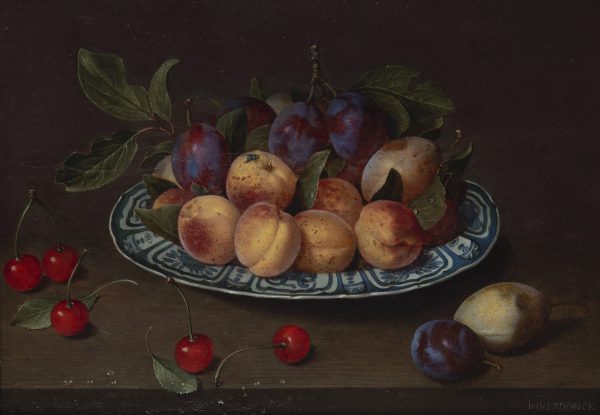Platter of plums, peaches and pears with cherries on a table, 1630-1640
Oil on panel, H. 0.26 m; W. 0.35 m
Signed lower right: IVHULSDONCK.
Provenance: Private collection.
The specific presence of the fruit painted by Jacob van Hulsdonck is due to his highly precise technique. Often seen from slightly above, these fruits are set against a dark background and are bathed in diffuse light. For the first time in still lifes, the shapes are really seen within an atmosphere.
A major Flemish still life painter of the early 17th century, Jacob van Hulsdonck was from Antwerp and did his apprenticeship in Middleburg in the Netherlands. This fact, noted by the historian F. J. van den Branden1, appears to be confirmed by the affinity of his style with that of Ambrosius Bosschaert the Elder (1573-1621). Born in Antwerp, he was also an apprentice in Middleburg where he was active until 1611. In 1608, Hulsdonck, back in Antwerp, became a master painter of the guild of St. Luke. He married in that city in 1609 and took pupils between 1613 and 16232. His wife, Maria la Hoes, with whom he had seven children, died in 1629. In 1632, he married Josina Peeters, who gave him an eighth child. From 1609 until his death in 1647, van Hulsdonck lived in the same house in Antwerp. His son, Gillis van Hulsdock (1625-1670) was also a still life painter.
Realism with a Decorative Effect
Hulsdonck’s subjects and style varied very little over his career. He showed arrangements of fruit, placed either in an open wickerwork basket, on a platter or in a Wan-Li Chinese porcelain bowl, all placed on a wooden table. His fruit is often shown from slightly above, in the manner of Osias Beert the Elder. The foreground of this table is usually littered with fruit, and sometimes with roses and carnations. While his shapes, which can be very pure, tend towards realism, his compositions are more decorative. Hulsdonck lightens his arrangements of fruits by including twigs and foliage.
A very particular presence
What distinguishes Hulsdonck’s style from other Flemish still life painters is the highly graphic precision, which gives the objects a very particular presence. He concentrates especially on recreating the appearance of textures. In a leaf for example, he spends time on analysing the network of minuscule veins and clearly delineates the edges of a line of bright colour. In addition, he seems to enjoy sprinkling his compositions with insects and dewdrops.
Soft Lighting
Like his contemporaries, he shows fruits against a dark brown or black background that reinforces the strength of colours. A skilful colourist, he creates multiple shades and is unusual for his interest in purplish shades. His carefully developed arrangements are bathed in very gentle and diffuse light. For the first time in the field of still life, the forms are really seen in the atmosphere. A very pleasant sentiment emanates from his paintings.
Hulsdonck’s Work
Hulsdonck uses mainly wood supports, sometimes copper. Museums and private collections share about forty signed still lifes3. It is hard to establish a chronology of his work because he did not date his paintings. The Musée des Beaux-Arts of Orléans owns a Basket of Plums4. Other still lifes with fruits by the artist can be found at the Bowes Museum in Barnard Castle (Durham), The Metropolitan Museum of Art in New York, in Florence at the Uffizi and in the M. H. De Young Memorial Museum in San Francisco.
- F.J. Branden, Geschiednis der Antwerpsche Schilderschool, Antwerp, 1883, I, p. 638. [↩]
- Edith Greindl, Les peintres flamands de natures mortes au XVIIe siècle, Paris, 1983, p. 34. [↩]
- Edith Greindl, Les peintres flamands de natures mortes au XVIIe siècle, Paris, 1983, p. 364. [↩]
- Oil on panel, H. 0,40 m; W. 0,61 m, signed IVHVLSDONCK FE. [↩]
